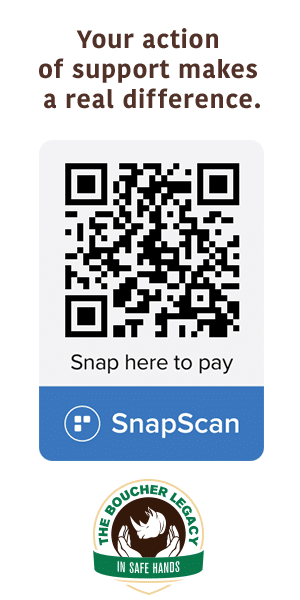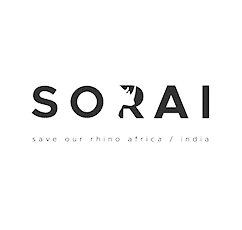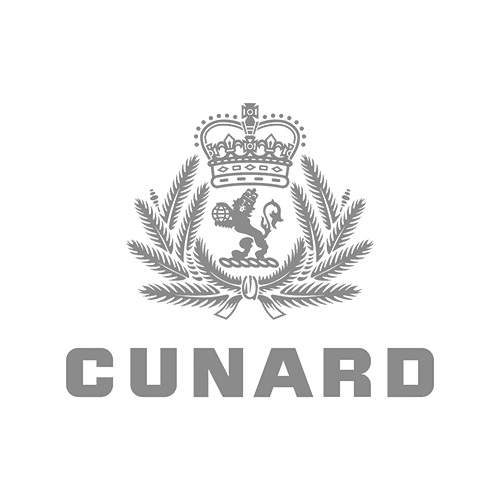
The Pangolin Diaries: Rampfy
As a follow on from our story on the plight of the pangolin we are pleased to share with you the story of pangolin survivor Rampfy whose recovery has been managed by the African Pangolin Working Group and the Johannesburg Wildlife Veterinary Hospital (JWVH) . Rampfy is the first of four pangolins whose rehabilitation will be sponsored by The Boucher Legacy.
Alastair Hewitt, co-founder of The Boucher Legacy says;
“Rampfy is one pangolin in a million, luckily one that survived in a million that have been destroyed over the past 10 years and it is very disturbing that the incidence of pangolin slaughter is on the rise. The Boucher Legacy has the same passion for pangolin that it has for rhino and other mammals, to protect what is ours and to do this through awareness, education and bringing perpetrators to book. In this particular instance, we are helping to rehabilitate pangolin that have been rescued.”
Alexis Kriel, Director of the African Pangolin Working Group, shares the heartwarming story of Rampfy the pangolin:
A pangolin on the road
At around 7am on 22 October 2018, a vet – Dr Helena Rampf – was driving along the R531 to her practise in Hoedspruit. The bushveld was dry – shades of brown and grey. It was impossible to imagine how it would go green overnight, after the first good rain. Originally from England, Helena loved this part of the world, where most people lived in private homes on wildlife estates bordering the Kruger Park and worked as rangers, safari operators and lodge managers. It was a peaceful scene, except for the presence of anti-poaching units that were deployed like private armies for countering the scourge of poaching. Nearing Hoedspruit, Helena noticed something in the road ahead. It looked like a piece of African art, an animal sculpture, that had fallen off the back of a bakkie, landing the right way up, in a standing position in the middle of the road. She slowed down as she drew closer. She was sure that it was a pangolin ornament – pangolins are the most poached mammal on the planet and are very rarely seen in the wild. She slowed down to have a look at it, but as she drew up alongside it, she saw that it was a live Temmincks ground pangolin pup, abandoned and looking confused.
How Rampfy got his name
As a vet, Helena was used to handling animals, she picked up the extraordinary creature and he curled into a ball, a little bigger than a grapefruit. Helena realized that he was too young to be separated from his mother, that he had probably been poached along with his mother, but she was nowhere to be seen. Sadly, his mother was never found, and was assumed to be lost to the trade. Helena put the frightened pup into her hat on the seat next to her, phoned through to Dr Genine Rabie of Provet in Hoedspruit, told her to expect them soon, and rushed him through to her. The pup had likely fallen out of a moving vehicle, he had tire marks on his back, and it became clear that he had been hit by a car. He was dehydrated, concussed, bleeding and very badly bruised and had marked neurological symptoms. “I think everyone fell in love with him then and there, quite frankly,” said Helena. They named the pangolin pup Rampfy, after Helena Rampf and that’s how he came to us.
Rampfy gets a human “Mom”
After 24 hours of intensive care treatment, and to everyone’s relief, Rampfy showed marked signs of improvement. His road to recovery would be long and costly, but there was hope that eventually he would be returned to the wild. Rampfy was 1.7kg’s and was only a few weeks old. He was transferred to vet nurses Jade Aldridge and Natalie Rogers, who had been trained in the care and husbandry of Temmincks ground pangolins by specialists from the Johannesburg Wildlife Veterinary Hospital (JWVH). Rampfy was hypothermic and terrified, he walked around in tight circles because of a head trauma and was shaking uncontrollably. In the beginning, the girls tried not to touch him too much because they were scared they would “push him over the edge”. Mammal babies depend on interaction from their mothers for their mental and emotional development and so Natalie began to spend time with him, helping him to adjust to his new environment, keeping him close to her where he could feel the warmth of her body and hear her heart beat. When Rampfy started to relax, he began sniffing her skin and licking her with his long sticky tongue – that tongue is so much a part of the pangolins very unique physiology, perfectly designed for excavating termateria and licking up ants. It took her a while to realise what he wanted. “There I was, looking at this gorgeous little baby, desperate to save him and I suddenly realised – milk, he wants milk!”
Learning to walk straight
Natalie describes Rampfy as a prickly little thing with a soft tummy, looking for the tenderness that only a mother can give. She sat him on her lap and initiated his feeding with a special milk formula in a syringe and with a miracle teat that you’d use for small animal mouths, like squirrels. Rampfy latched on as soon as he got a taste for it and transferred his dependency to two wonderful vet nurse “moms’”. Rampfy showed signs of recovering from his head trauma and Natalie started teaching him to walk straight, encouraging him towards her over the dusty paths of dry Hoedspruit days. In a normal situation, he would have gotten his first experiences of the world, clinging onto his mother’s back as she foraged outside of her burrow. He would have tried out the first cocktail ants as his mother excavated the terrain with her pointed snout and long sticky tongue. The ants would have scattered over her armour, fleeing for their lives, holding onto their fatty pupae and he would have realised that his long sticky tongue was perfect for catching them from between her scales. Outside of the clinic and the warm box that reminded him of the burrow, where he felt safe with his mother, Rampfy’s instincts kicked in. He loved the smell of the earth, dug holes with his claws and grew in grams day by day. “He’d start off looking for ants and then forget to eat and end up just digging holes,” said Natalie, laughing. But the vet nurses were struggling to find a good source of ants in Hoedspruit in the dry season. While Rampfy was ready to increase his intake of ants, he continued to love the comfort of his bottle of milk.
Watch the video to see Rampfy learning to walk:
Read the Pangolin Diaries – Part 2










